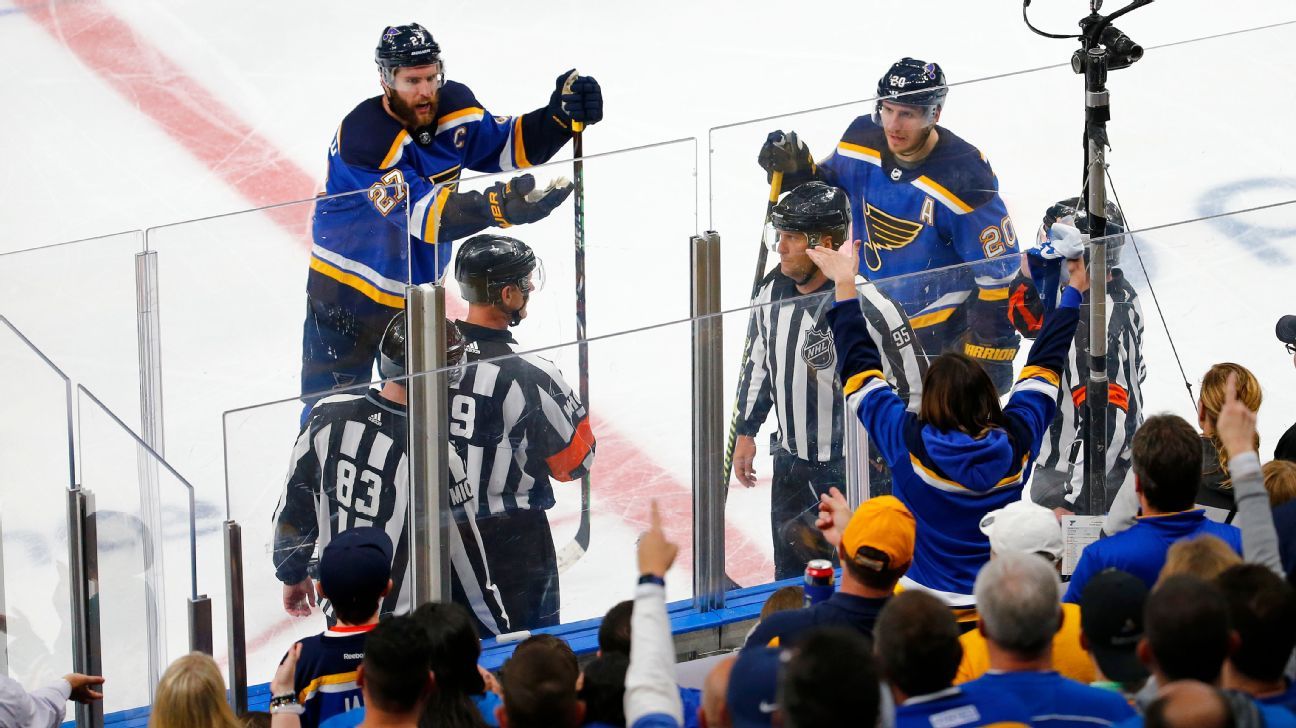VANCOUVER — After several embarrassing officiating controversies overshadowed the Stanley Cup Playoffs, the National Hockey League significantly increased the scope of its referees’ video review capabilities and added a third category to its coach’s challenges at Thursday’s general managers meeting in Vancouver.
“We view this as evolutionary. We don’t want it to be perceived as an overreaction,” said NHL commissioner Gary Bettman. “The increased use of video replay is something we’ve considered and discussed over time, and at this point and time we think it was the appropriate response to what we were seeing, coupled with our ability to do it.”
That said, there are clear links to this “evolution” of the coach’s’ challenge and video review, and the controversial missed calls from the 2019 playoffs.
Referees who call major or match penalties — not including those handed out for fights — will now be required to use video review to either confirm the call or reduce the penalty to a two-minute minor if it’s clear there was a mistake made on the severity of the penalty. They can consult any other on-ice official, but not the NHL’s situation room.
“The referee is going to review the call using advanced technology, and has the discretion to confirm the call, hopefully in most cases, or reduce the call to a minor penalty. He will not have the discretion to eliminate or rescind the penalty,” said deputy commissioner Bill Daly.
This rule change would cover plays like the controversial major penalty handed to Cody Eakin of the Vegas Golden Knights in their Game 7 loss to the San Jose Sharks, during the playoffs’ opening round. The Sharks, down 3-0, rallied with four goals on the subsequent five-minute major penalty and eventually won the game in overtime. The NHL apologized to the Golden Knights for the incorrect call, and the officials that worked the game did not again appear in the postseason.
The NHL is also empowering its referees to review double-minor penalties for high-sticking, in which one teammate’s stick hits another teammate or a players’ own stick strikes him in the head, or “friendly fire” situations as commissioner Gary Bettman termed it. These reviews will not be required, but rather will be discretionary. Like with the major penalty reviews, there will be no consultation with the NHL situation room.
In addition to interference on the goaltender and offside calls preceding goals scored, NHL coaches can now challenge plays in the offensive zone that should have resulted in play being stopped before a goal was scored.
That includes “black or white” plays like the missed hand pass that helped the Sharks win Game 3 of the Western Conference final in overtime, and the puck that bounced off the netting that resulted in a Columbus Blue Jackets goal in the Eastern Conference semifinal. It would also cover plays like the puck being hit with a teammates’ high stick before a goal.
There are no time limitations on these challenges, and there’s no mandate that a team must maintain possession of the puck during the missed call. The only restriction is that the puck must remain in the attacking zone through the missed stoppage and the goal being scored.
Bettman was clear that this new category of coach’s challenge would not cover “missed penalties,” such as the overlooked tripping call on St. Louis Blues forward Tyler Bozak took on Boston’s Noel Acciari in Game 5 of the Stanley Cup Final that led to a critical goal for the Blues.
“We’re not prepared to go there in terms of the game right now. That would be something that wouldn’t be terribly productive and would be terribly disruptive,” said Bettman.
The NHL also removed the limitations on how many times teams can use a coach’s challenge during the game. Now, teams can challenge however many scoring plays they like. If unsuccessful on the first challenge, it would result in a minor penalty for delay of game. If unsuccessful a second time and in any subsequent challenges, it would be a double-minor for delay of game. Currently, coaches need a timeout in order to challenge a goalie interference play.
“We don’t want lots and lots of challenges. We don’t want to disrupt the flow of the game,” said Bettman, “we only want challenges where it’s crystal clear that an egregious mistake has been made.”
The situation room in Toronto will continue to be responsible for initiating video review in the final minute of regulation time and overtime as well as continue to have final authority over all coach’s challenge video review decisions with input and consultation from both the on-ice officials and a former official staffed in the situation room.
In other NHL rules changes approved by the league’s general managers, after being suggested by the NHL’s competition committee:
HELMETS: Subject to further consultation with the NHL Players’ Association on precise language, a Player on the ice whose helmet comes off during play must (a) exit the playing surface, or (b) retrieve and replace his helmet properly on his head (with or without his chin strap fastened). A Player who is making a play on the puck or who is in position to make an immediate play on the puck at the time his helmet comes off, shall be given a reasonable opportunity to complete the play before either exiting the ice or retrieving and replacing his helmet. Failure to comply with the above will result in a minor penalty being assessed on the offending player. A Player who intentionally removes an opponent’s helmet during play shall be assessed a minor penalty for roughing.
LINE CHANGES FOR DEFENSIVE TEAM: The defensive team will not be permitted a line change when a goalie freezes the puck on any shot from outside the center red line. Similarly, if the actions of a skater of the defensive team cause a stoppage by unintentionally dislodging the net from its moorings, the defensive team will not be permitted to make a line change. In both of these instances, the offensive team will have the choice of which end zone dot the face-off will take place.
FACE-OFFS FOLLOWING AN ICING & TO BEGIN A POWER-PLAY: Following an icing as well as at the beginning of any power-play, the offensive team will have the choice of which end zone dot the face-off will take place.
AWARDED GOAL: If the goal post is deliberately displaced by a goalkeeper during the course of a “breakaway”, a goal will be awarded to the non-offending team.
PUCK OUT OF BOUNDS: When the attacking team is responsible for the puck going out of play in the attacking zone, in all instances, the face-off will be conducted at one of the two face-off dots in the attacking zone.
Bettman said there was a discussion about changing the puck over the glass rule that currently leads to a delay of game penalty, but said that inconsistency of camera coverage from arena to arena makes it difficult to tweak it.

